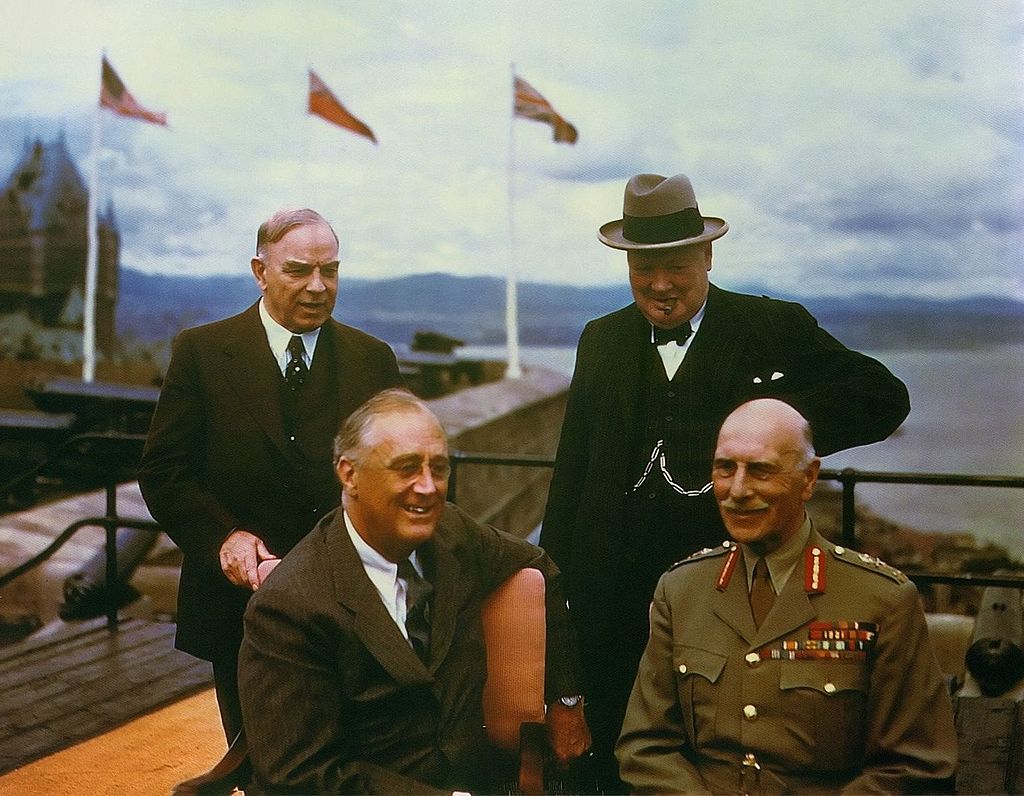Chapter 6. The War Years, 1914–45
6.13 Canada between the UK and the US

The fall of France in 1940 sent ripples across the Atlantic. It was clear that a German attack on North America was not unthinkable. Americans were increasingly concerned, although their government officially held fast to a policy of isolationism. If Britain fell — and it might — plans were afoot to transfer to Canada the Royal Family and the British government, along with whatever war material and resources could be saved. The Germans would never tolerate a government in exile so it was believed almost certainly that Canada would then be attacked.
Under these circumstances, King recognized the need to secure American support and on 16 August 1940, he met secretly with President Franklin Delano Roosevelt (1882-1945) in a railcar at Ogdensburg, New York. Out of that meeting came the Permanent Joint Board of Defense, a collaborative military body with oversight – though not control — over the armed forces of both countries. The Ogdensburg Agreement, as it came to be known, was an undeniable compromising of Canadian sovereignty but clearly one that King felt was essential under the circumstances. King’s own long experience of working with the Americans — he spent the Great War in the United States and was familiar with elite circles south of the border — made him more comfortable with this arrangement than would have been the case if the stridently pro-British leader of the Conservative party, Arthur Meighen, had been in office.
Canada’s economy was still reeling from the Depression and it lacked the financial wherewithal to put its industries on a wartime footing. Britain’s financial resources were also limited, so American involvement was required to underwrite British contracts. This Lend-Lease Agreement extended the life of Canadian sales to Britain and stimulated the Dominion’s industrial resurrection. Although the United States was not yet at war, it was building up its own arms and could turn to Canada for additional capacity. An arrangement to do so and integrate the two economies during the term of the war — the Hyde Park Agreement— was signed on 20 April 1941. Canada’s economic situation had suddenly and dramatically changed.
Goods could now be made but they had to be delivered as well. Following on Ogdensburg, arrangements were made to ship American supplies to Britain and Russia through Canadian ports. Doing so meant expanding the size of a pitiably small pre-War navy (seven warships) into a force that could contribute to the Battle of the Atlantic. Naval personnel tripled to 10,000 men and women by the end of 1940 while the Canadian fleet expanded rapidly as well.
In 1943 Canada would host a meeting between Roosevelt and British Prime Minister Winston Churchill. The First Quebec Conference allowed the two leading Allied powers — and to a lesser degree, Canada — to begin planning for the invasion and liberation of France. Throughout these meetings and in other negotiations involving the three nations, King played the role of the broker and the bridge; historians have tended to conclude, however, that King’s role was peripheral.
Key Points
- Britain’s vulnerability in 1940 persuaded King to look to the United States for financial and materiel support in the war effort.
- The Permanent Joint Board of Defense and the Ogdensburg Agreement mark the beginning of Canada’s new military relationship with the United States.
- The Lend-Lease Agreement was key in supplying wartime Britain and rebuilding Canadian manufacturing after the Depression.
- The Hyde Park Agreement involved a further integration of the North American economies.
- King’s objective was to position Canada as a middle power between Britain and the United States.
Media Attributions
- Québec Conference, August 1943 is licensed under a Public Domain license
The policy of isolating one’s nation-state from international turmoil and alliances.
Established in 1940. See Ogdensburg Agreement.
1940, a wartime accord signed between United States President Franklin D. Roosevelt and Canadian Prime Minister William Lyon Mackenzie King; produced the Permanent Joint Board of Defence.
Prior to declaring war against the Axis Powers in 1941, the United States agreed to support the Allied war effort by selling materiel to Britain on a deferred-payment program. Canada was able to take advantage of this arrangement, which led to rapid industrial recovery and expansion. See also Hyde Park Declaration.
A wartime pact between Canada and the United States; allowed Canadian-made goods manufactured for export to Britain to be covered under the Britain-USA Lend-Lease Agreement.
A nearly continuous series of naval confrontations that began in 1939 and ended only with the fall of Germany in 1945.

